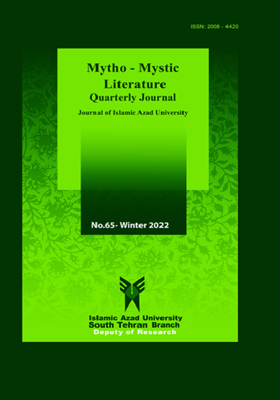-
-
List of Articles
-
Open Access Article
1 - A research on the divine and mystical face of Kaveh Ahangar in the folklore and narration of Shahnameh
behzad atooni Behroz Atoonī -
Open Access Article
2 - The Metaphoric and Metonymic Poles of Language in Sharh al-shathiyyat of Rouzbahan Bagali; A Study Based on the Theory of Roman Jakobson
farzane Cheharlang Iraj Mehraky -
Open Access Article
3 - The Common Features of Pir/Sheikh (Old Wise Man) in Asrār al-Tawhid and The Brothers Karamazov
azadeh hodeini arastoo mirani mohammadali mir -
Open Access Article
4 - Gnostic Elements in the Mystical System of Ayn al-Quzat Hamadani
Ebrahim Ranjbar Babak Savdagar -
Open Access Article
5 - The Mythological and Epic Themes in Common Proverbs of Fars Province
meysam zare zahra riahizamin -
Open Access Article
6 - The Story of the Tree and The Child of the People and the Myth of Medusa: A Comparative Study Based on the Theory of Castration Anxiety
Amir Hossein Zanjanbar -
Open Access Article
7 - Arvandrūd; From Mythological River of Ranghā, Arang and Aurvant to Tigris and Shatta Al-Arab: A Morphologic Approach
Javad shakeripour Safiyeh Moradkhani Tahereh Sadeghi Tahsili -
Open Access Article
8 - Mystical Distress From Fakhr-al-Din Iraqi's Point of View
mohammadjavad shams majid farhanizadeh -
Open Access Article
9 - The Analysis of Characters and Mythological Concepts in Symphony of the Dead
soheyla sheykhloo Hamidreza Ardestani rostami Ismail Azar -
Open Access Article
10 - The Role of Earth in the Mythologies and Beliefs of Nations; The Case Study: The Works of Sanai Ghaznavi
leila motie mohamad hadi khalegh zadeh mohamad rea masumi
-
The rights to this website are owned by the Raimag Press Management System.
Copyright © 2021-2025







